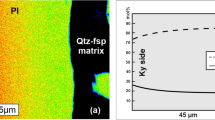Abstract
Replying to D. J. Lacks, J. A. Van Orman & C. E. Lesher Nature 482, (2012)
Lacks et al.1 argue that our model of isotopic fractionation in thermal gradients in silicate melts2 does not agree with measurements of the ratio of diffusivities seen in silicate melts. This statement is based on an over-interpretation of our model into non-steady-state applications, such as chemical fractionation, because the model we presented treats the quantized energy levels of the transition state as being equal to each other (the partition function Z(TS) = 1). This was warranted, as our main interest was in finding the steady-state solution to isotopic fractionation in a closed system (which is insensitive to the transition state). The potential importance of the transition state in determining the ratios of diffusivities of He isotopes in a geologic system has previously been noted3, and future work will need to clarify the importance of the transition state for kinetic isotopic fractionation in silicate systems, particularly the ratio of diffusivities.
Similar content being viewed by others
Main
Lacks et al.1 point out that isotopic fractionation due to temperature gradients in the gas phase have been observed (for example, ref. 4), but they do not provide proof that classical mechanics quantitatively explains these observations. Furthermore, Lacks et al.1 (and references therein) provide no evidence that molecular dynamics simulations reproduce the isotopic fractionations observed in real gas systems, much less high-temperature condensed phases. A full understanding of isotopic fractionation for complex (diatomic, polyatomic) species, even in the gas phase, is likely to require quantum mechanics because of the involvement of quantized vibrations5.
No evidence is presented by Lacks et al.1 that molecular dynamics simulations, based on Lennard-Jones interactions, are capable of reproducing the isotopic fractionations of elements and of capturing the strong potential energy interactions that characterize silicate melts and other systems where diffusion is a strong function of temperature. Because of the magnitude of the activation energies involved, only a very small fraction (f) of all particles acquire enough energy to overcome activation energy barriers: f ≈ exp−(−Ea/kBT). Here Ea is activation energy, kB Boltzmann’s constant, and T temperature. For typical activation energies of 2–3 eV, this fraction is rather small (∼10−8), thus making it difficult for molecular dynamics simulations, which typically employ ∼103 particles, to realistically capture the thermodynamics associated with isotopic fractionation in a highly interacting condensed matter system. We suggest caution in interpreting simple binary mixture molecular dynamics simulations that rely on ‘unphysical’ means of implementing heat transport6.
Last, Lacks et al.1 point out that the vibrational frequencies needed to explain the steady-state fractionations are physically unrealistic. We note that this frequency may or may not correspond to a physical frequency, as the initial reactant state consists of three independent vibrational components that we, for the sake of clarity and simplicity, incorporated into one effective frequency (thus the effective frequency would be higher than each of the independent components)7. The infrared vibrational features that are observed in natural systems are sensitive only to differences in energy levels, not the zero-point energy. We also note that, as infrared vibrational features in a silicate melt are overwhelmingly dominated by modes associated with Si–O stretching and bending, it is unclear whether Raman or vibrational infrared spectra include features associated with diffusing interstitial species such as Mg, Fe and Ca.
In short, Lacks et al.1 have provided no new data or physical model that quantitatively explains the empirical observations of steady-state isotopic fractionation in silicate melts. Furthermore, over 50 years of work in isotope effects in physical chemistry and isotope geochemistry support the role of quantum mechanics in isotopic fractionation processes.
References
Lacks, D. J., Van Orman, J. A. & Lesher, C. E. Isotope fractionation in silicate melts. Nature 482,http://dx.doi.org/10.1038/nature10764 (this issue).
Dominguez, G., Wilkins, G. & Thiemens, M. On the Soret effect and isotopic fractionation in high-temperature silicate melts. Nature 473, 70–73 (2011)
Trull, T. W. & Kurz, M. D. Isotopic fractionation accompanying helium diffusion in basaltic glass. J. Mol. Struct. 485–486, 555–567 (1999)
Grachev, A. M. & Severinghaus, J. P. Laboratory determination of thermal diffusion constants for 29N2/28N2 in air at temperatures from −60 to 0 °C for reconstruction of magnitudes of abrupt climate changes using the ice core fossil-air paleothermometer. Geochim. Cosmochim. Acta 67, 345–360 (2003)
Saxena, S. C. & Mathur, B. P. Thermal diffusion in isotopic gas mixtures and intermolecular forces. Rev. Mod. Phys. 38, 380–390 (1966)
Reith, D. & Florian, M.-P. On the nature of thermal diffusion in binary Lennard-Jones liquids. J. Chem. Phys. 112, 2436–2453 (2000)
Vineyard, G. H. Frequency factors and isotope effects in solid state rate processes. J. Phys. Chem. Solids 3, 121–127 (1957)
Author information
Authors and Affiliations
Corresponding author
Rights and permissions
About this article
Cite this article
Dominguez, G., Wilkins, G. & Thiemens, M. Dominguez et al. reply. Nature 482, E1 (2012). https://doi.org/10.1038/nature10765
Published:
Issue Date:
DOI: https://doi.org/10.1038/nature10765
Comments
By submitting a comment you agree to abide by our Terms and Community Guidelines. If you find something abusive or that does not comply with our terms or guidelines please flag it as inappropriate.



